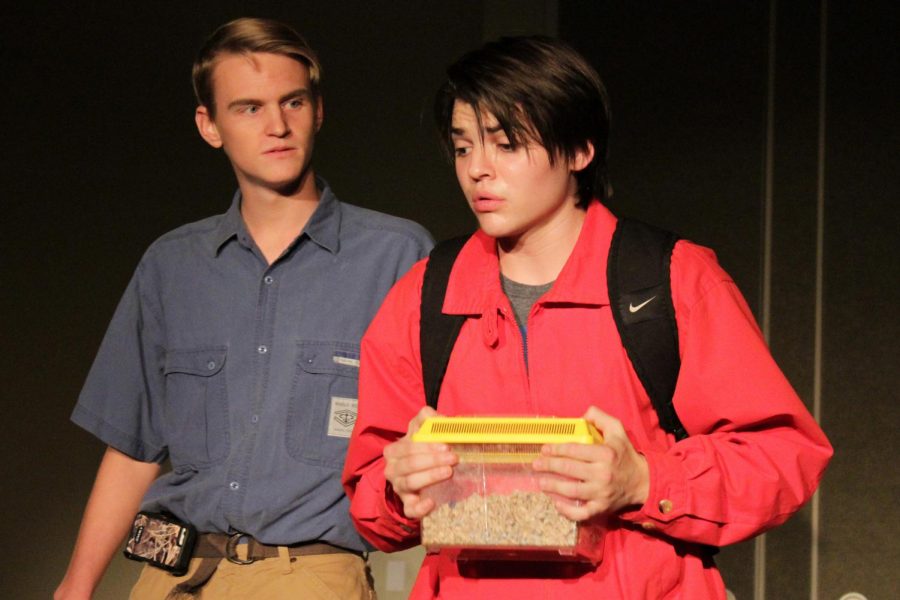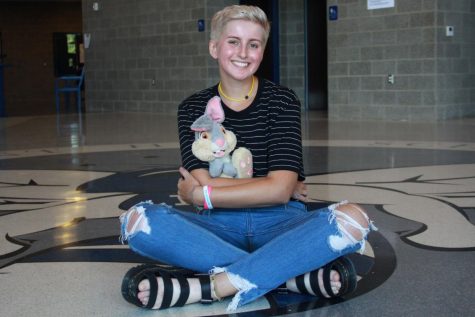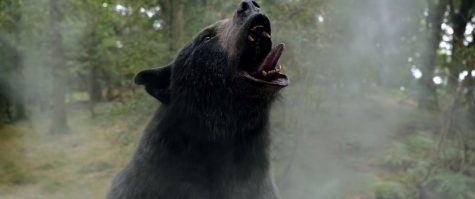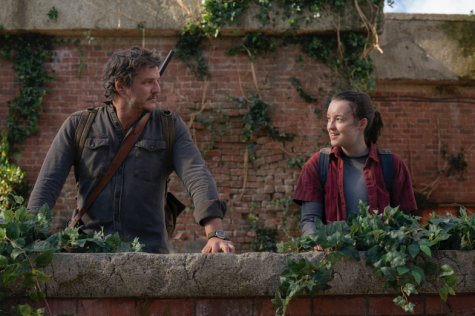“The Curious Incident of the Dog in the Night-Time” Review
Senior Elijah Glidwell holds a cage for a rat as he plays Christopher Boone.
December 20, 2018
Bryant’s theater department has put on productions year in and year out that keep audiences coming back for another peek at the talent that lies within our school. This year, Stage Management put on Mark Haddon’s “The Curious Incident of the Dog in the Night-Time,” which follows the story of 15-year-old Christopher Boone, a teenager living with autism, on his journey to find who killed the neighbor’s dog, Wellington. Faced with the challenge of telling the story of a boy with autism, the cast had to tread a fine line between offense and accuracy.
Upon entering the multipurpose room, chairs surrounded a square mat which would serve as the stage, and curtains draped around to act as dressing rooms. This bare bones setup made me skeptical of the quality of the upcoming performance. It seemed there were very few good seats, but attendees were allowed to move seats before the show began if there were more available.
The show opened with Christopher (senior Elijah Paul) lying over the dead dog, drawing the audience in to what seemed like a simple murder mystery. The first half of the show seemed to drag along, but as soon as projections (digital set designs projected onto a wall) began and Christopher’s father Ed Boone (junior Stanley Robinson), who was left to care for him when his wife abandoned them, and Christopher’s therapist, Siobhan (junior Jewell Regan) took the stage, it became clear that the next hour and a half would take the audience on an emotional ride through the struggles faced by families and children as they navigate life with autism.
With all of the cast members on stage at all times, the set changes and prop switches were quick and organized–props were put under small boxes that the remaining actors sat on. It allowed the focus to remain on the characters speaking and the purpose of each scene.
Further utilizing all characters on stage, the production was taken one step further, incorporating body movement into the show. In a scene describing a day at the beach, other characters lifted up Christopher’s mother, Judy Boone (junior Meredith Medford) and moved her along with the motions described by Christopher, moving her up and dipping her down with the waves. The added movement made up for the space, acoustics and lighting that the multipurpose room lacked.
Stage Management also featured two live animals in the show. Christopher’s best friend was a rat, Toby, and an actual rat made a few appearances in the show, carefully handled by cast and crew. At the end of the show, Christopher is given a dog, and the presence of an actual puppy, provided by junior Gretchen Bush, added to the heartwarming ending.
While the general performance and execution of the play was great, as usual, the relationship between Ed and Judy Boone was absolutely captivating. Each time either character was on stage, I could not keep my eyes off of them. They delivered passion and intense emotion with every line, and they pulled off a connection that captured the audience.
On Christopher’s end, Paul did a great job focusing on the story and purpose of his character rather than focusing on Christopher’s autism. Paul put on a performance that drew the audience into Christopher’s journey, making people see him as Christopher, a teenager in A-level maths who is living with autism, instead of just a boy with autism.
As someone who lives with a brother with high-functioning autism, I was worried that the production would downplay the hardships faced by people with autism and their families. I was scared that through the portrayal of Christopher, students would get the impression that people like Christopher–people like my brother–were misfits in society, incapable of functioning on their own.
That being said, I was relieved to see the struggles of living with autism and trying to support someone with autism displayed accurately and honestly, showing even the most raw and uncomfortable parts of the struggle. However, the show still reminded the audience that people with autism are not incapable of living on their own, solving their own problems or changing their story.
Overall, the performance, projections, costuming and set design were all executed with great attention to detail, which proved to withstand the small size of the multipurpose room. Stage Management, under the direction of Jeremy Clay, showed that they can put on a meaningful show despite location and content, doing the families of children with autism a huge favor.


















